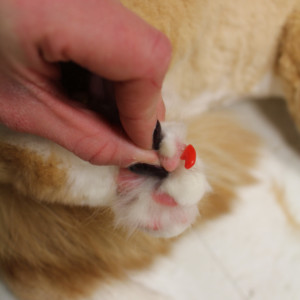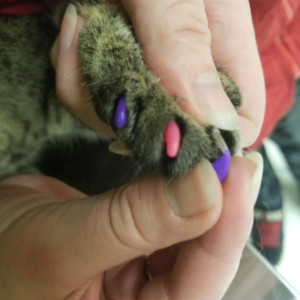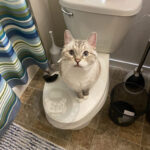Cat Claw Caps, also known as soft paws, are a popular solution for cat owners looking to prevent scratching damage to furniture, floors, and even themselves. However, there are several myths surrounding their use, leading some to question their safety and suitability for cats. Let’s debunk these common misconceptions and explore the truth about cat claw caps.
Myth 1: Cat Claw Caps Prevent Claws From Retracting Naturally
This is completely false. A cat’s claw retraction is a natural, effortless process that doesn’t involve pulling the nail back into the paw itself. When a cat relaxes, the claws retract to prevent contact with the ground during walking. Cat claw caps are designed to accommodate this natural movement. As long as they are correctly sized and applied – which includes proper nail trimming beforehand and using the appropriate amount of adhesive – cats can extend and retract their claws comfortably even with the caps on. The caps simply cover the nail tips without hindering the natural mechanics of the paw.
Myth 2: Cat Claw Caps Cause Damage to the Nail and Nail Bed
 Soft Paws cat claw caps are designed to be safe and non-toxic for cats, preventing damage to nails and nail beds when applied correctly.
Soft Paws cat claw caps are designed to be safe and non-toxic for cats, preventing damage to nails and nail beds when applied correctly.
When applied correctly, cat claw caps are designed to be completely safe and cause no harm to your cat’s nails or nail beds. Reputable brands, like Soft Paws, were developed by veterinarians specifically to be non-toxic and gentle for both cats and dogs. Proper application is key to ensuring safety and comfort, and it involves a few crucial steps:
- Correct Sizing: Choosing the right size cap is essential to ensure a comfortable and secure fit on each individual claw.
- Appropriate Adhesive Use: Use just enough glue to make the cap adhere properly, avoiding excessive glue that could overflow and come into contact with the cat’s fur, skin, or nail bed.
- Proper Nail Trimming: Nails should be trimmed slightly longer than for a standard trim, just past the hook tip. It’s also important to leave a small space between the base of the nail cap and the cat’s nail bed.
For owners unsure about the process, resources like online courses from institutions like the National Cat Groomers Institute offer guidance on nail trimming and soft paw application.
Myth 3: Scratching Posts Are Enough, Eliminating the Need for Cat Claw Caps
Scratching posts are indeed vital for feline well-being. They encourage stretching and flexing, provide an appropriate outlet for scratching instincts, protecting furniture, and allow cats to mark territory using scent glands in their paws. However, the common idea that scratching posts “file down” a cat’s claws to make them less sharp is a misunderstanding. Scratching actually helps cats shed the outer, dead layers of their nail sheaths, revealing sharper, new nails underneath.
Therefore, while scratching posts maintain healthy cat nails, they don’t inherently make them less sharp or prevent scratching damage. The process of applying claw caps, which includes nail trimming and sheath removal, combined with regular cap replacement (every 4-6 weeks is recommended, no more than 6-8 weeks), effectively manages nail sharpness. This approach allows cats to express their natural scratching urges while preventing potential harm to both property and people.
Myth 4: Cat Claw Caps Don’t Last Very Long
 Cat claw caps are a comfortable and temporary solution to protect your home and skin from cat scratches, while allowing cats to exhibit natural scratching behaviors.
Cat claw caps are a comfortable and temporary solution to protect your home and skin from cat scratches, while allowing cats to exhibit natural scratching behaviors.
It’s true that some cats may initially notice and even try to remove new claw caps, especially during the first few applications. This is a normal reaction, and most cats adapt to wearing them within a short period, typically a few weeks or after a few applications. Positive reinforcement plays a significant role in helping cats adjust. Using treats, engaging in play, and offering affection can distract them from focusing on the caps and create a more positive association with the nail trimming and application process.
Myth 5: Cat Claw Caps Are a Permanent, One-Time Solution
Cat claw caps are not designed to be a permanent fix. Cat nails continue to grow naturally beneath the caps. If left on indefinitely, the nails can grow too long, potentially causing discomfort. Even if a cat seems to tolerate the caps without issue initially, they should not remain on for longer than 6-8 weeks. Regular maintenance is necessary. After this period, any remaining caps should be removed using nail trimmers. It’s important to then trim and clean the nails before applying a fresh set of caps. This routine ensures nail health and continuous scratch protection.
Who Can Benefit from Cat Claw Caps?
Cat claw caps offer numerous benefits for a variety of cats and owners:
- Elderly Owners and Those with Delicate Skin: They are ideal for individuals with thin skin or conditions that cause easy bruising or bleeding, providing protection from accidental scratches.
- Families with Young Children: Claw caps minimize the risk of scratching injuries to children, especially during play.
- Homes with Valuables: They are perfect for households concerned about protecting antique furniture, delicate quilts, rugs, and other valuable items from scratch damage.
- Rough Playing or Aggressive Cats: For cats that tend to play too roughly or exhibit aggressive scratching behaviors, claw caps can help prevent injury and damage.
- Cats with Skin Issues: They can be beneficial for cats with skin conditions or chronic itching, reducing self-inflicted injury from scratching.
- Hairless Cats: Breeds like Sphynx, with their delicate skin, can benefit from claw caps to prevent accidental self-harm.
- Cats Prone to Getting Claws Stuck: For cats whose claws frequently snag on carpets, bedding, or clothing, claw caps can prevent these frustrating and sometimes painful incidents.
When Are Cat Claw Caps Not Recommended?
While beneficial in many situations, cat claw caps are not always suitable for every cat:
- Outdoor Cats: Cats that spend time outdoors rely on their claws for defense, climbing, and balance. Claw caps can hinder these natural abilities and are not recommended for outdoor cats.
- Uncommitted Owners: Consistent maintenance is crucial, requiring nail trims and cap replacements every 4-6 weeks. Owners unable to commit to this schedule should consider alternative solutions.
- Cats That Persistently Remove Caps: While most cats adapt, a small percentage may persistently bite or remove the caps even after multiple attempts. In these cases, claw caps may not be a viable option.
In conclusion, cat claw caps are a safe, humane, and effective tool for managing cat scratching when used correctly and responsibly. By understanding and debunking the myths surrounding them, owners can make informed decisions about whether claw caps are the right choice for their feline companions and households.

